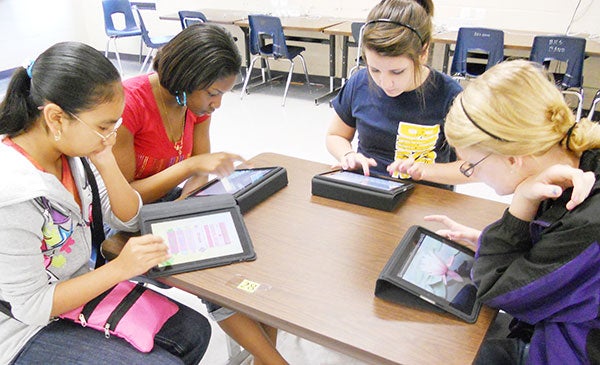Students now using iPads
Published 6:14 pm Monday, October 24, 2011
By DR. SUZI BONIFAY
Assistant Superintendent,
Decatur County Schools
Can you blog, wiki, connect globally, benchmark a process, frame problems and solutions, make complex choices, read a digital map, work in teams, and use digital tools to create engaging presentations that inform and motivate others?
Students will need all of those skills and more to succeed in the 21st century. Over the past three years, the Decatur County School System has been fortunate to reel in three federal Title II-D technology grants (approximately $850,000), in addition to two federal 21st Century Community Learning Center (CCLC) Grants (approximately $2 million). Competitive federal grants specify how monies are to be spent; II-D primarily on technology and training and 21st CCLC primarily on before and after school salaries, transportation, materials, equipment and training. Those federal dollars are making a difference in teaching and learning across all schools and have been crucial to improving 21st Century skills.
The first of the technology grants was designed to improve instruction in Advanced Placement classes, and provided Macbooks, iPods and wireless projectors for student use in AP U.S. History and AP Human Geography. The ability to access podcasts from university professors across the U.S., through iTunesU, and conduct research without leaving the classroom, encourages students to communicate and learn in new and compelling ways. The Increasing Student Literacy (ISL) Grant provided SMART boards, Macbooks and digital cameras for all ninth and 10th grade English classes, so students can improve skills in reading and writing by transforming reports and essays into dynamic, animated presentations featuring photos, movies and music. One of the videos created through the ISL grant, on the Winecoff Hotel fire, can be viewed online at bainbridgehigh.dcboe.com/?PageName=’AboutTheSchool’.
The Science, Technology, Engineering and Math (STEM) grant created two state-of-the-art labs at Bainbridge Middle and Bainbridge High that included teacher training and purchasing of video conferencing equipment, SMART boards, macbooks, iPads, student response systems, graphing calculators, digital cameras, hydroponics and ag-related technology equipment, biotechnology equipment, solar panels and a host of other digital tools. Video conferencing equipment has given teachers the opportunity to have live conversations with other STEM educators and will allow students to conduct live conversations with scientists and students across the globe.
In science, math and agriculture, students have used digital probes and graphing calculators for real-time data acquisition, displays and analysis. With partners from the Teaching Institute for Excellence in STEM the program is expanding elementary outreach and strengthening collaboratives with higher education, business and industry. Per grant guidelines, approximately 75 percent of each grant has been spent on equipment, software, and related tools, with the remaining portion spent on training for the instructional and leadership staff.
The 21st CCLC program, the largest of all the grants, funds the before- and after-school programs in elementary, middle and high school, and has an emphasis on language arts, math, science, wellness and the arts and is using technology tools to engage students. While elementary and middle schools focus on remediation, the high school offers credit recovery (retaking a class previously failed) and credit accrual (taking a course the first time) using online coursework, thus helping students to take additional courses and/or graduate on time.
Federal dollars earmarked for technology and improving student achievement are being used to provide tools to help students solve problems, help adults improve the learning environment and help both groups meet technology standards.
At the Oct. 11 professional learning day, teachers, academic coaches, school and system leaders and support personnel received training on iPads. Math coach Deborah Watson said the iPad had already allowed her to provide better service to teachers by having all the digital math resources and data at her fingertips.
As a part of this project, the iPad will also connect to the video library of resources for educators through Observation 360 — a tool designed to allow instructional leaders to perform more effective classroom observations. Observers can use the device to provide immediate feedback to teachers and embed video segments which show teachers how to improve specific skills in standards-based classrooms — a win-win for teachers and students.


